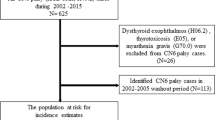Abstract
Purpose
To determine the cause and prognosis of neurologically isolated third, fourth, or sixth cranial nerve dysfunction in cases of oculomotor palsy, and to determine the best imaging methods to make a correct diagnosis.
Methods
The medical records of 221 consecutive patients with oculomotor palsy caused by neurologically isolated cranial nerve dysfunction were reviewed. There were 63 cases of third, 41 of fourth, and 117 of sixth cranial nerve dysfunction. The patients were examined at the Neuro-ophthalmology Clinic of Kyoto University Hospital between 1993 and 2001.
Results
Vascular disorders accounted for 34.9% of the third nerve dysfunction, and 90% of these recovered completely in 6 months. Ninety percent of the patients with an isolated third nerve dysfunction that was caused by an aneurysm also had anisocoria, and 68% of the patients with a third nerve dysfunction caused by a vascular disorder had anisocoria. In all of the vascular cases with anisocoria, the difference in the pupillary diameter was <1.0 mm. The presence of ptosis did not play an important role in making a diagnosis of third nerve dysfunction. Ninety percent of the patients with fourth nerve dysfunction and 60% of the patients with sixth nerve dysfunction recovered within 9 months.
Conclusions
The age of the patient, signs of an improvement, and associated alterations are important diagnostic markers to determine the best type of imaging methods for evaluating neurologically isolated third, fourth, and sixth cranial nerve dysfunction.
Similar content being viewed by others
References
Wolfe JT, III, Scheithauer BW, Dahlin DC. Giant-cell tumor of the sphenoid bone. Review of 10 cases. J Neurosurg 1983;59:322–327.
Rucker CW. Paralysis of the third, fourth and sixth cranial nerves. Am J Ophthalmol 1958;46:787–794.
Rucker CW. The causes of paralysis of the third, fourth and sixth cranial nerves. Am J Ophthalmol 1966;61:1293–1298.
Rush JA, Younge BR. Paralysis of cranial nerves III, IV, and VI. Cause and prognosis in 1000 cases. Arch Ophthalmol 1981;99:76–79.
Richards BW, Jones FR Jr, Younge BR. Causes and prognosis in 4278 cases of paralysis of the oculomotor, trochlear, and abducens cranial nerves. Am J Ophthalmol 1992;113:489–496.
Lee AG, Onan HW, Brazis PW, Prager TC. An imaging guide to the evaluation of third cranial nerve palsies. Strabismus 1999;7:153–168.
Lee AG, Brazis PW. The emerging role of magnetic resonance angiography in the management of patients with third nerve palsy. Am J Ophthalmol 2000;129:115–116.
Jacobson DM. Pupil involvement in patients with diabetes-associated oculomotor nerve palsy. Arch Ophthalmol 1998;116:723–727.
Jacobson DM. Relative pupil-sparing third nerve palsy: etiology and clinical variables predictive of a mass. Neurology 2001;56:797–798.
Jacobson DM, Trobe JD. The emerging role of magnetic resonance angiography in the management of patients with third cranial nerve palsy. Am J Ophthalmol 1999;128:94–96.
Peters GB, III, Bakri SJ, Krohel GB. Cause and prognosis of non-traumatic sixth nerve palsies in young adults. Ophthalmology 2002;109:1925–1928.
Patel SV, Mutyala S, Leske DA, Hodge DO, Holmes JM. Incidence, associations, and evaluation of sixth nerve palsy using a population-based method. Ophthalmology 2004;111:369–1375.
Holmes JM, Mutyala S, Maus TL, Grill R, Hodge DO, Gray DT. Pediatric third, fourth, and sixth nerve palsies: a population-based study. Am J Ophthalmol 1999;127:388–392.
Lavin PJ, Donahue SP, Jacobson DM, et al. Isolated trochlear nerve palsy in patients with multiple sclerosis. Neurology 2000;55:321–322.
Author information
Authors and Affiliations
About this article
Cite this article
Akagi, T., Miyamoto, K., Kashii, S. et al. Cause and prognosis of neurologically isolated third, fourth, or sixth cranial nerve dysfunction in cases of oculomotor palsy. Jpn J Ophthalmol 52, 32–35 (2008). https://doi.org/10.1007/s10384-007-0489-3
Received:
Accepted:
Published:
Issue Date:
DOI: https://doi.org/10.1007/s10384-007-0489-3




